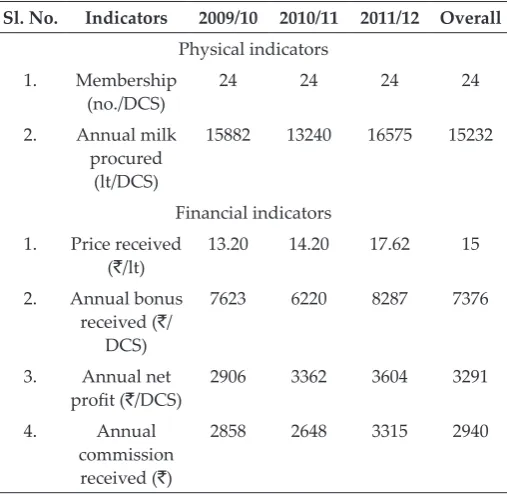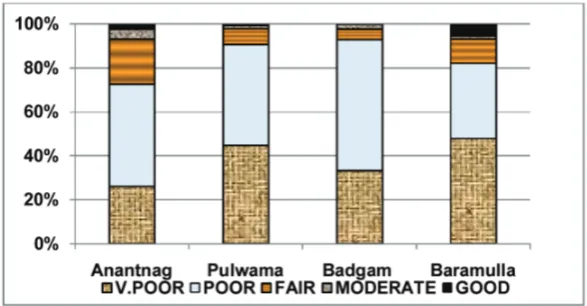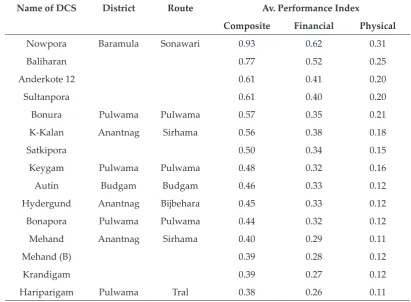achieved?
Shahnawaz A. Rather, Janailin S. Papang* and Smita Sirohi
Department of Dairy Economics, Statistics and Management (DESM), National Dairy Research Institute, Karnal, Haryana, IndiaABSTRACT
Dairy cooperatives that are mandated to be an instrument of rural development have transformed the rural economy in several parts of the country. The present investigation was carried out to study the performance of dairy cooperatives in Kashmir region. The study is based on secondary data collected from J&K Milk Producers Cooperative Limited. The performance of dairy cooperative societies (DCS) was assessed in relative terms using indexing technique. The results indicated that the physical and financial performance of most of the DCS was far from satisfactory, primarily due to reduced membership and hence, low level of milk procurement. Out of 344 DCS analysed in the study, only a handful of 15 DCS had registered moderate to good level of performance. Keywords: Cooperative sector, dairy, milk, price, Kashmir
Address for correspondence
Janailin S. Papang: Department of Dairy Economics, Statistics and Management (DESM), National Dairy Research Institute, Karnal, Haryana, India
E-mail: janai4ndri@gmail.com Access this article online
Publisher Website:
http://www.ndpublisher.in
DOI: 10.5958/0976-4666.2016.00026.7
production, marketing and processing of milk and milk products (Candler and Kumar, 1998; Cunningham, 2009) and thereby contributing towards livelihood security of the millions of milk producers in the country (Singh and Pundir, 1998).
In 1983, during the Operation Flood period, the institution of dairy co-operative was introduced in the state of Jammu and Kashmir. The two prevailing Milk Supply Schemes in the country that were under the administrative control of the State Animal Husbandry Department were converted into two federations, namely Kashmir Valley Milk Producers Co-operative Federation in Kashmir and Jammu Milk Producers Co-The modern day dairy co-operative structure in the
operative Federation in Jammu. Both these Federations registered Dairy Cooperative Societies and established a network of Societies that started supplying milk to these Federations. However, due to mounting losses both these Federations could not sustain the regular operations of procurement and processing and were liquidated. In 2004, the J&K Government initiated efforts to revive the liquidated Federations with the help of Gujarat Co-operative Milk Marketing Federation Limited (AMUL). Subsequently a new organization in the name of Jammu &Kashmir Milk Producers Co-operative Limited (JKMPCL) came into existence for dairy development activities in J&K state with the proactive support of AMUL. The two dairy plants under JKMPCL are claimed to be running profitably (JKMPCL, 2012).
This paper evaluates the performance of the village level dairy co-operative societies (DCS) in Kashmir region to examine whether the dairy co-operatives in the region are showing improvement regarding coverage and financial aspects.
D
ataanDM
ethoDologyThe study is based on the secondary data for the period of three years from 2009-10 to 2011-12 collected from the records of the JKMPCL. The performance of the DCS was assessed in relative terms by constructing an average performance index for TE 2011-12. Two types of performance indicators were considered in the study: physical indicators, comprising of 2 variables, quantity of milk procured annually and number of members of a DCS and the financial indicator comprising of 4 variables, price received per litre of milk, annual bonus, net profit received by a DCS and commission earned by Secretary of DCS. For the construction of performance index, this study follows the approach developed by Iyengar and Sudarshan (1982) which is the generalization of relative approach underlying the Human Development Index developed by UNDP (1990). Its advantages are it is simple to use and is free from the restrictive assumption of linearity in the relationship of indicators.
The first step is to construct the index (Yis) for each of the six variables and sth DCS;
Yis = Xis– MinXis
MaxXis – MinXis i = 1, ..., 6; s = 1, ...,n (i)
Where, Xis represents the triennium average value of ith performance variable of sth society.
The numerator in equation measures the extent by which the sth society is better in the ith variable as compared to the society having worst performance. The denominator is the range, i.e., the difference between the maximum and a minimum value of given indicator across the societies, which is a simple statistical measure of total variation presented in the variable.
After calculating the Yis for all the variables, the second step is to calculate the physical, financial and finally, composite performance indices for each society. The indices for each society were worked out using arbitrary weights reflecting the relative importance of variables.
Physical index: YsP= w
1Y1s+ w2 Y2s (ii) Financial index: YsF = w
3Y3s+ w4Y4s+ w5Y5s+w6Y6s (iii)
Composite index: YsC= Y
sP+ YsF= w1Y1s+ w2Y2s + (iv) w3Y3s + w4Y4s + w5Y5s + w6Y6s
The weights were taken as varying inversely as a variance in the respective performance indicators.
w
k
Y
i
=
( )
var
1 0 < wi <1 and w1 + w2 + w3 + … + w6 = 1 (v)k Yi i = ( ) =
∑
1/ 61 1
var (vi)
The choice of the weights in this manner ensures that large variation in any one of the indicators will not unduly dominate the contribution of the rest of the indicators and distort inter-society comparisons. It is well known that, in statistical comparisons, it is more efficient to compare two or more means after equalising their variances. The composite index YC
R
esultsanDD
iscussionThe present study covers all the dairy co-operative societies in Kashmir region that existed in one or more years during 2009/10 to 2011/12. Over the years, their number has been fluctuating as some societies were closed down and some new ones were created. Although dairy co-operative movement in the state has been revived since 2004, the AMUL model of the three-tier structure is not yet fully operational. The village level milk producers’ co-operative societies are procuring milk in 9 districts of the state, but due to low procurement levels, at present, there is hardly any concept of milk union at the districts. There are only two processing plants, one at Cheshme Shahi, Srinagar and another at Satwari, Jammu. The products of JKMPCL are marketed under the brand name of “Snow Cap”. It produces a very limited range of the products like pasteurized double toned, toned milk, full cream milk, dahi, ghee and flavoured milk.
In the span of three years, there was a marginal net increase in the number of village level societies under JKMPCL in the Kashmir region. In 2009-10, there were 220 societies (Table 1), of which 45 closed down due to low and irregular milk procurement. In an attempt to
increase the coverage of dairy co-operatives, 48 new societies were created and hence in 2010-11 their total number remained more or less unchanged. During 2010-11 the number of newly created societies (76) was more than closed down (48) and hence by 2011-12 their number rose to 255. There are 11 milk routes in Kashmir valley covering all the districts except the far flung district of Kupwara. The maximum number of milk routes (6) and societies (99) are in Pulwama district, followed by district Anantnag. Pulwama is the largest milk producing district in the state, and is popularly called as “Dudha-Kul of Kashmir”.
The dairy co-operative societies were very few (9) in the Srinagar district. Hence it has been shown with neighbouring district of Baramulla. Like Srinagar, the coverage of co-operative network is very scanty even in Budgam district. The proximity of the area to Srinagar city perhaps provides greater alternative milk market outlets to the dairy farmers and hence, in both, Srinagar & Budgam, the co-operatives have not succeeded in expanding their network. In the other districts of the state, the dairy co-operative network covers less than one third of the villages (Table 2) indicating that there is vast potential of future expansion in the region.
Table 1: Number of Dairy Co-operative Societies in Kashmir Valley
Particulars Year District Total
Anantnag Pulwama Budgam Baramula
Bijbehara Sirhama Yaripora Chakora Litter Newa Tral Shopian Pulwama Budgam Sonawari/
Pattan
No. of DCS 2009-10 24 20 14 13 6 4 24 - 37 35 43 220
Closed DCS 2010-11 3 5 1 1 2 3 5 - 8 8 9 45
Created DCS 8 3 - 2 1 1 4 - 7 8 14 48
No. of DCS 29 18 13 14 5 2 23 - 36 35 48 223
Closed DCS 2011-12 4 4 1 1 1 - 6 - 7 6 14 44
Created DCS 4 12 2 7 - - 2 12 13 9 15 76
No. of DCS 29 26 14 20 4 2 19 12 42 38 49 225
Total 69 (27.05) 99 (38.82) 38 (14.90) 49 (19.22) 225
Table 2: Percentage of villages covered by cooperatives: District Wise (2011-12)
Sl. No. District Total no. of
villages covered by DCS% of villages
1. Anantnag 361 19
2. Pulwama 329 30
3. Budgam 482 8
4. Baramulla 172 29
Notwithstanding the marginal increase in the number of societies, the average membership has stagnated at low level of 24 members per DCS. The average annual milk procurement was only 15232 litres per DCS indicating that a very small proportion of milk produced is being supplied to the co-operatives (Table 3). Milk is procured only once in a day (morning) hence, in summer season when despite of cool weather, the chances of spoilage of raw milk milked during the evening hours are high, the farmers supply milk to the alternate market outlets. The average annual procurement decreased in 2010-11 compared to previous year, due to higher frequency of law and order problems in the Valley during the year.
Table 3: Average Value of Performance Indicators
Sl. No. Indicators 2009/10 2010/11 2011/12 Overall Physical indicators
1. Membership
(no./DCS) 24 24 24 24
2. Annual milk procured
(lt/DCS)
15882 13240 16575 15232
Financial indicators 1. Price received
(`/lt) 13.20 14.20 17.62 15 2. Annual bonus
received (`/ DCS)
7623 6220 8287 7376
3. Annual net
profit (`/DCS) 2906 3362 3604 3291
4. Annual
commission received (`)
2858 2648 3315 2940
The average prices received by the farmers have shown rising trend over the years with increase being particularly notable (> ` 3/litre) in 2011-12 as compared
to 2010-11. The milk purchase rate of co-operatives in Kashmir region is comparable to procurement price in other parts of the country. For instance, in Maharashtra presently (June 2013) farmers are getting ` 18.50/litre for
milk with 3.5% fat and 8.5% SNF. In Kashmir also, as the farmers are mostly reading cross-bred cattle the fat content in milk is low.
The JKMPCL is also distributing annual bonus to the society. The bonus is spread at the end of the financial year and depends on upon the total milk procured by a given society. During the period of study, the average annual bonus per society was about ` 7400 (Table 3).
The dairy co-operative societies were not giving full-time salary to the secretary who was responsible for their milk collection, but the commission was paid depending upon the milk supplied to the milk plant. Both the Commission and the price payment of the milk collected were provided after ten days to a given society. During the period of study the average annual commission paid was about ` 3000 per DCS.
During the period of study, all DCS had positive net profit, however, in some the amount was very meager. The annual net profit for the societies ranged from ` 0.65
to 27400, with the overall average of ` 3300 per society.
Table 4: Classification of DCS according to Composite Performance Index
(nos.) Operational Status
Performance Status &
Index Av. Value of Index Functioning from 2009/10-2011/12 Created after* 2009-10 Closed after* 2009-10 Total No. of Societies
Very Poor (0.04-0.154) 0.122 15 39 79 133 (38.67)
Poor (0.155-0.269) 0.200 91 59 9 159 (46.22)
Fair (0.270-0.383) 0.317 30 7 1 38 (11.05)
Moderate (0.384-0.500) 0.439 8 - - 8 (2.32)
Good (0.501-0.950) 0.673 6 - - 6 (1.74)
Total 0.197 150 105 89 344
Note: Figures in parenthesis are % of total
*Performance index computed based on average value of financial & physical indicators for the years the DCS was functional
The performance status of about 85% DCS in the region was poor to very poor. A large number of these societies (88) were closed down after 2009-10. The predominant percentage (93%) of DCS that had been created after 2009-10 and those functioning for all the three years (71%) also have low-performance indices ranging from 0.039 to 0.269. Just a handful of 15 DCS have registered moderate to good level of performance, and another 37 can be considered as fair performers. The reason for low
performance are low membership and hence little milk procurement.
Across districts, the Baramulla & Srinagar show the relatively better status of DCS followed by Anantnag (Figure 1). Out of top 15 DCS first four are from Baramulla (Table 5); 6 societies from Anantnag; 4 from Pulwama and 1 from Budgam.
Figure 1: District Wise Performance of DCS
The district of Pulwama had a maximum number of milk routes but on the Chakora, Litter and Newa milk routes the performance index of DCS was in general low, perhaps because the private processors were also operating in this milk-shed area. In relative terms, the
Table 5: Top Fifteen Societies According to Performance Index
Name of DCS District Route Av. Performance Index
Composite Financial Physical
Nowpora Baramula Sonawari 0.93 0.62 0.31
Baliharan 0.77 0.52 0.25
Anderkote 12 0.61 0.41 0.20
Sultanpora 0.61 0.40 0.20
Bonura Pulwama Pulwama 0.57 0.35 0.21
K-Kalan Anantnag Sirhama 0.56 0.38 0.18
Satkipora 0.50 0.34 0.15
Keygam Pulwama Pulwama 0.48 0.32 0.16
Autin Budgam Budgam 0.46 0.33 0.12
Hydergund Anantnag Bijbehara 0.45 0.33 0.12
Bonapora Pulwama Pulwama 0.44 0.32 0.12
Mehand Anantnag Sirhama 0.40 0.29 0.11
Mehand (B) 0.39 0.28 0.12
Krandigam 0.39 0.27 0.12
Hariparigam Pulwama Tral 0.38 0.26 0.11
A cross-classification of DCS on the basis of physical and financial performance status shows high degree of association between the two aspects (Table 6). This means that a low physical performance index also leads to a low financial performance index. Hence, it is imperative that the DCS expand their membership so that milk procurement can go up and financial performance follows suit.
Based on the growth rates in milk procurement, the 150
DCS which continued for all three years were classified into expanding (showing positive growth), stagnant (no growth) and contracting (negative). Among the 150 societies more than 41% were growing, about 24% were inactive and 35% were contracting type (Table 7). Further among the districts Pulwama had 57% societies in the expanding class, while as Anantnag was having 43% contracting DCS, indicating good percentage of growing societies in the former district.
Table 6: Cross Classification of Societies on the Basis of Physical and Financial Performance
Physical
Class Poor
(0.04) Moderate (0.15) Good (0.28)
Poor (0.14) 312 -
-Financial Moderate (0.28) 16 14
Table 7: Distribution of DCS according to Trend in Milk Procurement (2009/10-2011/12)
Trend Anantnag Pulwama Budgam Baramula Total
Expanding 14 28 8 12 62 (41.33)
Stagnanting 13 11 6 5 35 (23.34)
Contracting 20 10 6 17 53 (35.33)
Total 47 49 20 34 150
Note: Figures in parenthesis are percentage of total
c
onclusionThe results indicate that even after nearly a decade of rejunivation of the institution of dairy cooperative in the state, the performance of most of the societies was far from satisfactory which can be attributed to their low membership and hence lower milk procurement.
In order to strengthen the institution of cooperative in the state, there is a need to launch an aggressive membership drive, particularly focusing on younger and progressive dairy farmers in the region, who can in turn be important extension contacts for other farmers in the future. Increasing the density of milk collection centres in the existing area of operation may not be economically viable hence, the provisioning of input services should be made a priority. The JKMPCL should coordinate with the line departments of the government and other non-government agencies for providing efficient breeding, feeding, health care and extension services to its members.The input support services can condition the increase in membership, number and productivity of dairy animals and hence, milk procurement of the cooperatives.
The JKMPCL also needs to improve the infrastructure to enhance procurement and avoid milk losses. At present, milk procurement by the societies was carried only once a day. The installation of bulk milk coolers can make it possible to collect milk twice daily and prevent storage of milk in the hot months of the year as well as in eventuality of delay in supply to the dairy plant.The farmers also informed due to frequent law and order problems the milk vans were not able to able to deliver milk to the dairy plant and it was returned to them thus, making them wary of participation in the cooperative market channel.
The payment of renumerative prices of milk are an incentive for the farmers but, from the long run perspective, payment of higher procurement prices would not be a suitable proposition for the DCS unless the level of milk supply increases. Well-coordinated efforts of animal husbandry department, agricultural district of the state and JKMPCL are the need of the hour to hasten the process of dairy development in the state in general, and cooperative network in particular.
R
efeRencesCandler, W. and Kumar, N. 1998. The Impact of Dairy Development in India and the World Bank’s Contribution, The World Bank, Washington, D.C.
Cunningham, K. 2009. Rural and Urban Linkages: Operation Flood’s Role in India’s Dairy Development, International Food Policy Research Institute, Washington, D.C.
Iyengar, N.S. and Sudarshan, P. 1982. “A Method of Classifying Regions from Multivariate Data”, Economic and Political Weekly
26(1): 45-52.
JKMPCL 2012. 8th Annual Report 2011-2012, Jammu and Kashmir
Milk Producers Co-operative Limited (JKMPCL), Srinagar. Singh, K. and Pundir, R.S. 1998. Dairy Development in India:
Retrospect and Prospect. Research Paper 15, Institute of Rural Management, Anand.




